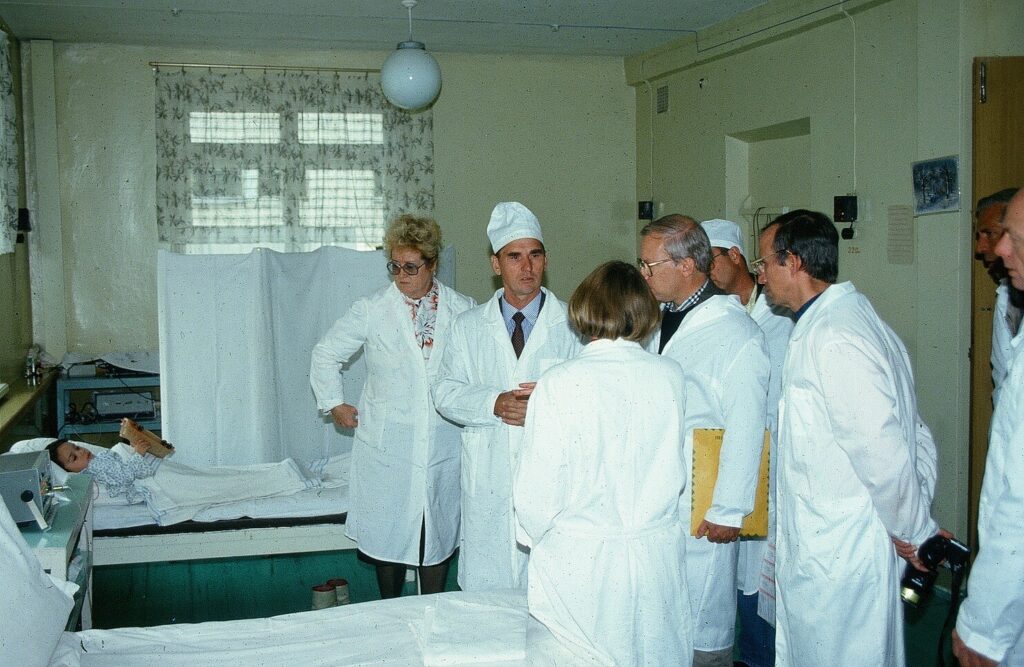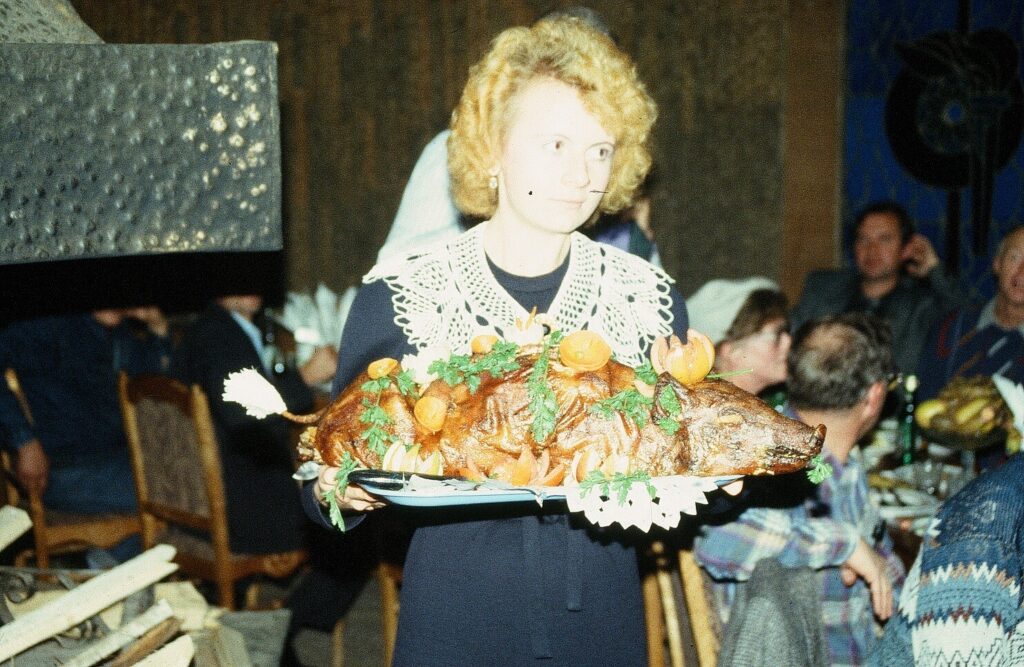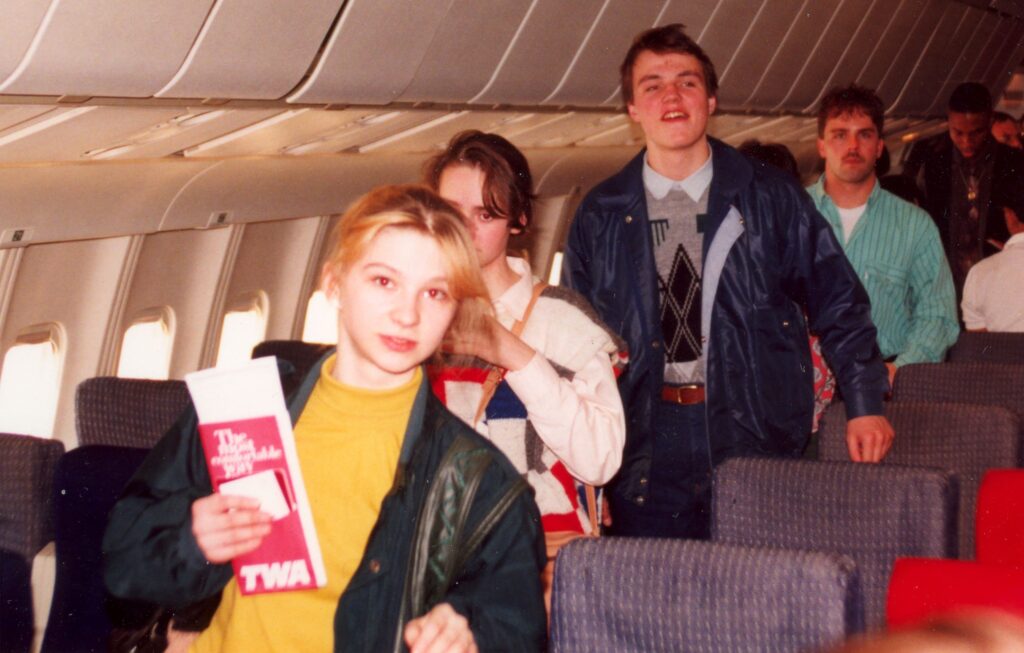Lab-to-Lab: US-Russian Lab-to-Lab Collaboration Story [Archived]
Early Lab-to-Lab | Export Control | Nielsen Jr. | Symposia | WSSX
Physics | Reminiscences of Russia | Caroline (Cas) Mason
- Setting the Stage
- Forming Collaboration
- Frequent Experimental Campaigns Part 1
- Frequent Experimental Campaigns Part 2
- Broadening and Declining Collaboration
- Restoring Collaboration
- Epilogue 2006-2016
- Concluding Remarks
September, 1993
The two-and-one-half week stay of the LANL team (Ekdahl, Goforth, J. King, Reinovsky, Rodriguez, Veeser, Younger, and myself) in Sarov for preparation, execution, and data analysis of the first experiment in September 1993 was the longest period a group of Americans had ever spent in Sarov. The period provided a number of opportunities to interact with VNIIEF leadership and Sarov residents as well as the VNIIEF experimental team (video link).
It was an indescribable feeling for the team to be inside the security fences of a town that “didn’t exist on any maps” only a few years earlier and to be working at an experimental test site that had been used to help develop nuclear weapons that had been aimed at the United States. The presence of the LANL team surely must have been amazing to the Russians as well, because in April of 1992 President Yeltsin had decreed that all security regulations of the old Soviet system were still in place until further notice; technically, the visits by LANL personnel to VNIIEF were illegal.
A CNN camera and news team arrived in Sarov on Tuesday, September 21, the day before the first experiment, fully prepared to cover the historic event. Unfortunately, Boris Yeltsin decided to lock out Parliament that evening. Furthermore, it appeared that CNN’s only other Moscow camera team had been aboard an airplane carrying numerous journalists that had been reported as shot down that day over Georgia. Consequently, the CNN team in Sarov had to forego covering the actual experiment (although they did cover some preparatory work) and instead turned around and returned to Moscow on Wednesday, to cover the political events in that city. It is ironic that while CNN was permitted to enter VNIIEF to cover the experiment, the US Department of Energy declined permission for them to film the December, 1993, collaborative experiments in Los Alamos (CNN was subsequently permitted to film the MAGO-II experiments at Los Alamos in October, 1994).
We learned quickly that September in Sarov is not as temperate as September in Los Alamos. When four members, including myself, arrived as an advance team, outside high temperatures were only 45 degrees Fahrenheit and, unfortunately, the Sarov central heating plant had not yet been started for the winter, so hotel room temperatures dropped to as low as 55 degrees. At this point early in Sarov’s transition from a secret town, communications with the outside world were difficult. Nevertheless, with the help of our hosts, we were able to send messages back to Los Alamos asking the remaining team members to bring with them a long list of our warmer clothes that arrived none too early.
As had happened on previous trips, and would happen on all subsequent trips, our VNIIEF hosts went out of their way to make sure that our non-working hours in Sarov were far from boring (in fact, some future trips were so intense that at times we longed for some boredom). Weekend excursions took us to monasteries, markets, and museums outside the city.

Fig. 13. Autograph-seeking students from Sarov school #2 surround Bob Reinovsky (September 1993).
During two visits to school #2, we were inundated by student questions about life in America. Showing that they understood the gravity of the global situation well, one group of students sang a song entitled “Let the peace last forever,” with lyrics that began with “It is easy to blow up our planet. All it takes is a button to be pressed …” and concluded with “Are we here, in this world, being born into it only to destroy it, So that our children would never know how beautiful it is? … But there is still some time left to save our world.” One visit provided an opportunity to show slides of Los Alamos to a large number of students gathered in the school auditorium.
The second school visit was followed by a visit of the entire LANL team to the children’s wing of the Sarov hospital. Whereas the visits to school #2 had been tremendously uplifting, the visit to the hospital was very sobering. Most of the 40 beds in the children’s wing (for children less than four years of age) were empty because so little medicine was available that many sick children were being sent home untreated. The team was shown a premature baby (approximately 3 lbs. at birth) with none of the life support equipment that would be common in the US. The medicine cabinets contained less medicine than found in the homes, or perhaps even the suitcases, of the LANL team members.

Fig. 14. The LANL team visits the Sarov medical center (September 1993).
Dr. Valentina Ponomoreva, a pediatrician, told us that medical supplies were available in Russia, but only at a price that was beyond the financial means of the hospital. We informed her that the Los Alamos community had been exploring means of providing medical assistance to Sarov, and the discussion made us realize that the most efficient and most expedient way to provide help was through direct cash contributions.
A VNIIEF leader expressed that the amount of contributions would not be as important as the expression of concern by the Los Alamos community, a conjecture supported by Ponomoreva’s letter expressing thanks for a substantial personal contribution made by the LANL team:
Please receive our sincere gratitude for the interest regarding not only scientific work, but towards us, the citizens of Sarov and our children. Your meetings with children, the visit to our children’s hospital, is the sign of your humanism and heartiness. Nowadays we are living the times of the crisis in the state power and national economy, that is the reason of children’s suffering. The food quality decrease, the lack of the necessary medicine do not allow us to execute our duties in protecting them from suffering. That is why we shall gratefully accept the help to the children in case it comes from kind and pure hearts of the Los Alamos citizens.
The “Sarov Children’s Medical Fund” was started by Dr. John Eilert, Mrs. Carrie Zocco, and myself shortly after my return to Los Alamos. For many subsequent trips, the LANL team would load as many medical supplies as possible into any spare space in their suitcases and deliver them to Sarov. Occasionally, cash from the medical fund was also carried.
Vladimir Rogatchev and Vladimir Pavloskii (Alexander’s son) led the LANL team on a walking tour of much of the Sarov residential area. This tour lasted approximately two hours and was said to be the first time outsiders were permitted to take such a walk and the first time that cameras of foreigners were permitted. It was obvious as the team walked through the town site that brightly dressed, picture-taking groups of tourists were not a common sight.
Although the Rogatchev home was not in the official security plan, it was decided during our walk that we would “notice” that we were nearby, and stop in for a social call. “Coincidentally,” dinner had been set for twenty people when we arrived. A second such coincidence happened on an early evening later in the visit when the bus we were on, ostensibly for another tour around town, stopped at Mokhov’s home, although such a visit had not been on the formal agenda. As it turned out, Mokhov’s wife had prepared a complete supper, which the LANL team felt obliged to eat even though we had previously eaten a full meal at the House of Scientists.
VNIIEF’s pride in hosting LANL scientists has always been evidenced by our visits to cities outside of Sarov. We were taken to the city of Saransk where the mayor hosted us at a rather lavish dinner which included roasted suckling pig, three salads, caviar, tomatoes, sausage, cabbage rolls, Smirnoff vodka, Pepsi Cola, and Spumante champagne.

Fig. 15. A waitress in Saransk brings a suckling pig to the table for the LANL team (September 1993)
April, 1994
A 10-member LANL team (R. Chrien, Ekdahl, C. Findley, Goforth, R. Kirkpatrick, H. Oona, Reinovsky, Rodriguez, J. Shlachter, Younger, and myself) spent two-and-one-half weeks in Sarov in April, 1994, for another joint experiment, this time giving the U.S. its first look at VNIIEF’s MAGO magnetized plasma formation system. This experiment again combined LANL’s diagnostics and computations with a truly unique VNIIEF capability.
Sarov’s Saturday schools sessions gave us more opportunities to meet with students. We toured school #2’s computer classroom and were told, proudly, that an e-mail link was expected to be installed by September so that students could communicate with students throughout the world, particularly in Los Alamos. We were shown the area in a school hallway where a “museum” commemorating the school’s interactions with Los Alamos would be located. The LANL team countered a student song and dance concert with “The Los Alamos Family Singers,” accompanied by Goforth and Oona on the harmonica, introducing ourselves with “you (the students) have shown us what can be done with much talent and much practice, so now we’ll show you what can be done with absolutely no talent and no practice.”
At school #2, Vladimir V. Chernyshev, grandson of V. K. Chernyshev, told us about a newly formed school association known as “Rainbow” which was formed to “reflect the many-sided activities between our towns and our countries.” The rainbow was chosen as the organization’s emblem because the rainbow is fresh, appears after the rain (“no contacts between our towns before”), and, even though the rainbow disappears, the memory of it remains. The association had more than 100 members and intended to invite students from Los Alamos, and other communities, to participate.
And we made our first visit to school #15, a visit that grew out of the “pen-pals” correspondence with the Los Alamos Middle School. Students from school #15 also treated us to some songs, including an English-rendition of “We shall overcome.” We were shown a glass-enclosed wall display about the U.S. that included a variety of items signifying the LANL/VNIIEF collaboration and the interactions between the students. A teacher called the display a “window to the US” which had significance not unlike the “window to Europe” opened by Peter the Great. A visit to a Physical Education class resulted in an impromptu basketball game between the school’s freshman basketball team and an unlikely team consisting of four heavily-shod, tie-clad LANL scientists and our VNIIEF security escort.
At both schools, Bob Reinovsky presented copies of a “Friendship Book” that had been prepared by Los Alamos students in conjunction with a LANL Bradbury Science Museum exhibit entitled “Russian/American Collaboration–the Transition to Peacetime Research,” which had opened in December, 1993, and which highlighted the LANL/VNIIEF collaboration. The original copy of the book had been presented to VNIIEF Director Belugin by the Museum staff during Belugin’s visit to Los Alamos in January, 1994. The book contained approximately 200 pieces of student artwork, all on the theme of peace and increasingly friendly relations between the two cities, and two nations. In his presentation, Reinovsky emphasized that the hopes of students in both countries are the same, and selected several pieces from the book to illustrate this point; one stated that “a man can be too proud to fight.”
We had our first meeting with the Sarov English-Speaking Club, where the members welcomed the opportunity to practice their language skills with native speakers and where we formed some lasting friendships. It became commonplace for us to specifically request that the English-Speaking Club be put on our social agenda.
Dr. Ponomoreva informed us that four premature babies had died in the six-month period since our last visit. She was very anxious to report her usage of moneys previously provided through the Arzamas-16 Children’s Medical Fund. Extremely appreciative, she explained that “the Arzamas-16 doctors and nurses thought that Los Alamos was so far away, but now it seems very close.”
Once again, it seemed like our VNIIEF hosts wanted to share us with the surrounding communities. Sirens screamed and lights flashed as our bus’s police escort drove in the center, or to the left, of the highway, often forcing oncoming traffic to the shoulder of the road, as we entered the city of Arzamas, some 40 miles from Sarov; the police car even challenged a railroad train at a grade crossing (we had received a similar escort in June, 1992, when a bus took us from Sarov to a picnic at Dubki resort, perhaps 20 miles east of Sarov). Tours of the city and museums were followed by a luncheon hosted by the city’s vice-mayor.
The return to Sarov included a stop at the Diveevo convent, where we were astonished at the progress that had been made since our first visit in August, 1993 at restoration of the original cathedral and at construction of a new cathedral. To us Americans who have always lived in an environment of religious freedom, the restoration of cathedrals at Diveevo and elsewhere stands as an important symbol of the positive changes in Russia.

Fig. 16. Sarov students board an airplane en route to the US to participate in the New Mexico High School Critical Issues Forum on Nuclear Dismantlement (April 1994).
Because of a fortuitous delay in the April, 1994 experimental schedule, we were able to assist a Sarov delegation of eight high school students and two high school teachers in their travels to Los Alamos to participate in a LANL-sponsored New Mexico High School Critical Issues Forum on Nuclear Dismantlement. Approval for the trip from high levels in the Ministry of Atomic Energy was required since Sarov students and teachers had never previously been permitted to leave the Soviet Union. Particularly because of the Russian perspective brought to the Forum by the Sarov teams, the Forum was an overwhelming success. This unprecedented visit to the US by residents of Sarov was another strong indication of the growing trust and respect that had been carefully established through the LANL/VNIIEF collaboration and was an important step in integrating Sarov into the global community.
Next >> Frequent experimental campaigns and reciprocal visits 1993-1997: Part II >>
